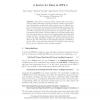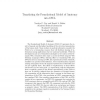197 search results - page 6 / 40 » Representing Phenotypes in OWL |
JAMIA
2011
12 years 10 months ago
2011
Background Systematic study of clinical phenotypes is important for a better understanding of the genetic basis of human diseases and more effective gene-based disease management....
SEMWEB
2009
Springer
14 years 2 months ago
2009
Springer
This paper outlines the first stage of the ODARyT Tool, a semantic web approach to represent and retrieve information in a corporate memory. After a brief discussion about the mee...
SEMWEB
2009
Springer
14 years 2 months ago
2009
Springer
Being able to extend an OWL ontology with some form of rules is a feature that many ontology developers consider as very important. Nevertheless, working with rules in practice can...
SEKE
2004
Springer
14 years 29 days ago
2004
Springer
We present an approach for mapping an OWL ontology into Java. The basic idea is to create a set of Java interfaces and classes from an OWL ontology such that an instance of a Java ...
WS
2008
ACM
13 years 7 months ago
2008
ACM
The Foundational Model of Anatomy (FMA) [7] represents the result of manual and disciplined modeling of the structural organization of the human body. Many workers in medical info...



